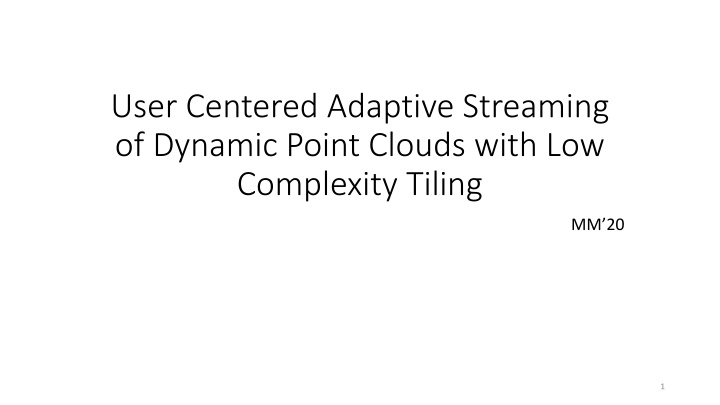
Dynamic Point Cloud Streaming with Tiled-Based Strategy
This research explores a user-centered adaptive streaming approach for dynamic point clouds utilizing a tiled-based strategy with low complexity. The method involves dividing point clouds into non-overlapped tiles, enabling users to freely observe objects and navigate while recording their interactions for rate adaptation experiments. A virtual camera in a quadrilateral shape is used to assign points to tiles based on camera orientation. The study also examines playback strategies, experiments with MPEG codecs, and presents conclusions on utility evaluation and bitrate allocation strategies. Future work includes network adaptation in multi-user telepresence applications.
Download Presentation

Please find below an Image/Link to download the presentation.
The content on the website is provided AS IS for your information and personal use only. It may not be sold, licensed, or shared on other websites without obtaining consent from the author. If you encounter any issues during the download, it is possible that the publisher has removed the file from their server.
You are allowed to download the files provided on this website for personal or commercial use, subject to the condition that they are used lawfully. All files are the property of their respective owners.
The content on the website is provided AS IS for your information and personal use only. It may not be sold, licensed, or shared on other websites without obtaining consent from the author.
E N D
Presentation Transcript
User Centered Adaptive Streaming of Dynamic Point Clouds with Low Complexity Tiling MM 20 1
Outline Intro Tiling Strategy Experiment Result Conclusion 2
Intro Contribution Tiled-based point cloud DASH streaming strategy 4 non-overlapped tiles for a single dynamic point cloud object Dataset MPEG 8i User is freely observe point cloud objects Recording the navigation for rate adaptation experiments Codec-agnostic 3
Tiling Strategy 4 Virtual Camera in quadrilateral shape Assume the point cloud object presents convex hull Draw a vector from centroid to each point Dot product with camera orientation to assign point to each tile 4
Playback Strategy U(Ti) = Ti is visible if U(Ti) > 0 Vo is the viewing angle Ti is the orientation of the tile Bitrate allocation Greedy Highest utility tile get the highest quality first (5, 1, 1, 1) Uniform Every tile increases quality one step at a time(3, 2, 2, 2) Hybrid Tiles with positive Utility uniformly increased first (4, 4, 1, 1) 5
Experiments MPEG anchor codec Octree space partitioning structure to encode point cloud geometry Color is mapped and encoded as 2D grid and applying JPEG compression JPEG quantization parameter from 55 to 95 in increments of 10 Budget The encoded size for the Common Test Condition compression profiles supplied with the MPEG V-PCC Codec at each decision point Pre-recorded navigation patterns Computing PSNR on the YUV channel Background RGB[0, 177, 85] Providing maximal contrast with respect to the content 6
Conclusion Tiling point cloud objects into 4 non-overlapped pieces Use utility function to evaluate visibility and evaluate 3 bitrate allocation strategy Limitation Assume client has omniscient knowledge of user Assume convex hull Cannot use teleport Static bitrate Future work Tiling approach with network adaptation in multi-user 6DoF telepresence application 8
